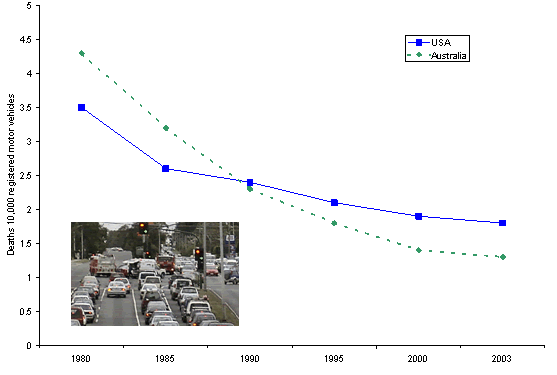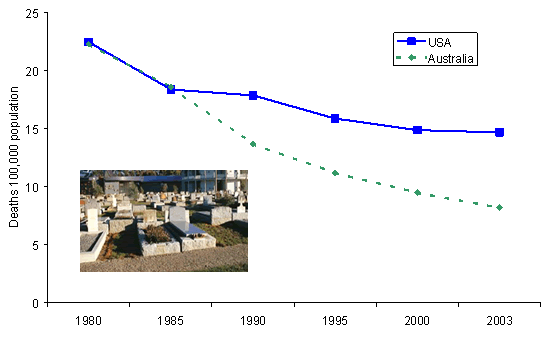U.S. Department of Transportation
Federal Highway Administration
1200 New Jersey Avenue, SE
Washington, DC 20590
202-366-4000
The primary measure of traffic safety progress in the United States is the death rate per 100 million vehicle miles traveled and this rate is at a historic low. However, all Western motorized nations are similarly and continuously reducing their death rates per unit of road use and many have made far greater gains than the United States. Among these, Australia has the most comparable type of road transport system and is therefore a valuable benchmark. Figure 1 shows that the Australian death rate per unit of road use has decreased far faster and further than the U.S. rate.
Figure 1. Road traffic deaths in the United States versus Australia per 10,000 registered motor vehicles (comparable estimates of distances traveled are unavailable). (Source: Data extracted from Web sites of USDOT and Australian Transport Safety Bureau.)

The public health measure of traffic safety-the rate of death per head of population from a motor vehicle crash-tells the same story (figure 2). From nearly identical rates in 1980, the Australian rate has fallen to a point where it is now little more than half the U.S. rate.
Figure 2. Road traffic deaths in the United States versus Australia per 100,000 population. (Source: Data extracted from Web sites of USDOT and Australian Transport Safety Bureau.)
In motorized societies, road crashes are the single most common cause of unintentional death in the first five decades of human life, making road trauma one of the major public health problems of the 21st century. The real story is told not by rates, but by the actual number of debilitating injuries and deaths among a nation’s citizens.
The sheer volume of road use-numbers of vehicles, numbers of drivers, and distances traveled-increases inexorably over time. Unless improvements in the rate of safety outstrip increases in the volume of road use, then the total number of people seriously injured or killed will increase. This is exactly what is happening in the United States; while the safety rate continues to improve, it is not at a sufficient level to prevent an increase in the total numbers killed. Table 1 shows that the number of persons killed in road crashes in the United States has increased by 2 percent in the past 10 years. In contrast, the number of persons killed in Australia has decreased by more than 20 percent in the same period, with improvements in the rates of traffic safety two to three times greater than those achieved in the United States.
| Total deaths |
Deaths per 100,000 population |
Deaths per 10,000 vehicles |
|
|---|---|---|---|
| United States | |||
| 1995 | 41,798 | 15.9 | 2.1 |
| 2004 | 42,636 | 14.7* | 1.8* |
| % change | +2% | -8% | -14% |
| Australia | |||
| 1995 | 2,013 | 11.2 | 1.8 |
| 2004 | 1,596 | 8.0 | 1.2 |
| % change | -21% | -29% | -33% |
* 2003
Source: Data extracted from Web sites of USDOT and Australian Transport Safety Bureau.
| << Previous | Contents | Next >> |